Source Contributions to Rural Carbonaceous Winter Aerosol in North-Eastern Poland
Abstract
1. Introduction
2. Experiments
2.1. Diabła Góra Site Description
2.2. Auxiliary site Preila description and sampling
2.3. Sampling and Chemical Analysis at Diabła Góra
3. Meteorological and Source Apportionment Analysis
3.1. Meteorological Data and Production of Meteorological Air Mass Back Trajectories
3.2. Source Apportionment of Domestic Wood Combustion
3.3. Source Apportionment of Domestic Coal Combustion and Traffic Exhaust
- The combined wood and coal combustion source contribution had to be higher than the contribution from only the wood combustion source as estimated from the levoglucosan method at all times. Otherwise, coal combustion contributions would be too small.
- The source contribution from the traffic source should be higher than roughly 10% at all times, which means contribution from the combined domestic wood and coal sources of maximum about 90%. It is reasonable to assume that traffic should contribute at least to a small extent, even during intense domestic heating periods or periods with substantial combustion of agricultural waste in the Kaliningrad area. Please see also the discussion in the second last paragraph in this section about the sensitivity analysis of the traffic source contribution.
- Reference wavelengths were 370 and 950 nm (in Sandradewi et al. [20] these were 470 and 950 nm).
- AAE from domestic wood and coal combustion was 1.93.
- AAE from traffic exhaust was 1.03.
- Source contributions to CM of the combined wood and coal source were allowed to approach maximum 90%, at the same time as they had to be higher than the wood contribution calculated with the levoglucosan method.
4. Results and Discussion
4.1. Air quality Situation
4.2. Source Apportionment
4.3. Meteorological Influence on Concentrations and Source Apportionment
4.4. Comparison with a Nearby Lithuanian Site
5. Conclusions
Author Contributions
Funding
Acknowledgments
Conflicts of Interest
References
- Lelieveld, J.; Klingmüller, K.; Pozzer, A.; Pöschl, U.; Fnais, M.; Daiber, A.; Münzel, T. Cardiovascular disease burden from ambient air pollution in Europe reassessed using novel hazard ratio functions. Eur. Heart J. 2019, 40, 1590–1596. [Google Scholar] [CrossRef] [PubMed]
- Englert, N. Fine particles and human health—A review of epidemiological studies. Toxicol. Lett. 2004, 149, 235–242. [Google Scholar] [CrossRef] [PubMed]
- Cho, S.-H.; Tong, H.; McGee, J.K.; Baldauf, R.W.; Krantz, Q.T.; Gilmour, M.I. Comparative Toxicity of Size-Fractionated Airborne Particulate Matter Collected at Different Distances from an Urban Highway. Environ. Health Perspect. 2009, 117, 1682–1689. [Google Scholar] [CrossRef] [PubMed]
- Baxter, L.K.; Duvall, R.M.; Sacks, J. Examining the effects of air pollution composition on within region differences in PM2.5 mortality risk estimates. J. Expo. Sci. Environ. Epidemiol. 2013, 23, 457–465. [Google Scholar] [CrossRef] [PubMed]
- Löndahl, J.; Massling, A.; Pagels, J.; Swietlicki, E.; Vaclavik, E.; Loft, S. Size-Resolved Respiratory-Tract Deposition of Fine and Ultrafine Hydrophobic and Hygroscopic Aerosol Particles During Rest and Exercise. Inhal. Toxicol. 2007, 19, 109–116. [Google Scholar] [CrossRef] [PubMed]
- Pope, C.A., 3rd; Burnett, R.T.; Thun, M.J. Lung Cancer, Cardiopulmonary Mortality, and Long-term Exposure to Fine Particulate Air Pollution. JAMA 2002, 287, 1132–1141. [Google Scholar] [CrossRef]
- Rückerl, R.; Schneider, A.; Breitner, S.; Cyrys, J.; Peters, A. Health effects of particulate air pollution: A review of epidemiological evidence. Inhal. Toxicol. 2011, 23, 555–592. [Google Scholar] [CrossRef]
- Pope, C.A.; Dockery, D.W. Health Effects of Fine Particulate Air Pollution: Lines that Connect. J. Air Waste Manag. Assoc. 2006, 56, 709–742. [Google Scholar] [CrossRef]
- IARC, International Agency for Research on Cancer (IARC). Outdoor Air Pollution. In Monographs on the Evaluation of Carcinogenic Risks to Humans; IARC: Lyon, France, 2016; Volume 109. [Google Scholar]
- Janssen, N.A.H.; Hoek, G.; Simic-Lawson, M.; Fischer, P.; van Bree, L.; ten Brink, H.; Keuken, M.; Atkinson, R.W.; Anderson, H.R.; Brunekreef, B.; et al. Black Carbon as an Additional Indicator of the Adverse Health Effects of Airborne Particles Compared with PM10 and PM2.5. Environ. Health Perspect. 2011, 119, 1691–1699. [Google Scholar] [CrossRef]
- Janssen, N.A.H.; Gerlofs-Nijland, M.E.; Lanki, T.; Salonen, R.O.; Cassee, F.; Hoek, G.; Fischer, P.; Brunekreef, B.; Kzyzanowski, M. Health Effects of Black Carbon; The WHO European Centre for Environment and Health: Bonn, Germany; World Health Organisation Regional Office for Europe: Copenhagen, Denmark, 2012. [Google Scholar]
- Grahame, T.J.; Klemm, R.; Schlesinger, R.B. Public health and components of particulate matter: The changing assessment of black carbon. J. Air Waste Manag. Assoc. 2014, 64, 620–660. [Google Scholar] [CrossRef]
- Laskin, A.; Laskin, J.; Nizkorodov, S.A. Chemistry of atmospheric brown carbon. Chem. Rev. 2015, 115, 4335–4382. [Google Scholar] [CrossRef] [PubMed]
- Alfarra, M.R.; Prevot, A.S.H.; Szidat, S.; Sandradewi, J.; Weimer, S.; Lanz, V.A.; Schreiber, D.; Mohr, M.; Baltensperger, U. Identification of the Mass Spectral Signature of Organic Aerosols from Wood Burning Emissions. Environ. Sci. Technol. 2007, 41, 5770–5777. [Google Scholar] [CrossRef] [PubMed]
- Kocbach, A.; Li, Y.; Yttri, K.E.; Cassee, F.R.; Schwarze, P.E.; Namork, E. Physicochemical characterisation of combustion particles from vehicle exhaust and residential wood smoke. Part. Fibre Toxicol. 2006, 3, 1. [Google Scholar] [CrossRef] [PubMed]
- Canagaratna, M.R.; Jayne, J.T.; Ghertner, D.A.; Herndon, S.; Shi, Q.; Jimenez, J.L.; Silva, P.J.; Williams, P.; Lanni, T.; Drewnick, F. Chase Studies of Particulate Emissions from in-use New York City Vehicles. Aerosol Sci. Technol. 2004, 38, 555–573. [Google Scholar] [CrossRef]
- Pöschl, U. Atmospheric Aerosols: Composition, Transformation, Climate and Health Effects. Angew. Chem. Int. Ed. 2005, 44, 7520–7540. [Google Scholar] [CrossRef]
- Petzold, A.; Ogren, J.A.; Fiebig, M.; Laj, P.; Li, S.-M.; Baltensperger, U.; Holzer-Popp, M.; Kinne, S.; Pappalardo, G.; Sugimoto, N.; et al. Recommendations for reporting “black carbon” measurements. Atmos. Chem. Phys. 2013, 13, 8365–8379. [Google Scholar] [CrossRef]
- Kirchstetter, T.W.; Novakov, T.; Hobbs, P.V. Evidence that the spectral dependence of light absorption by aerosols is affected by organic carbon. J. Geophys. Res. Atmos. 2004, 109. [Google Scholar] [CrossRef]
- Sandradewi, J.; Prevot, A.S.H.; Szidat, S.; Perron, N.; Alfarra, M.R.; Lanz, V.A.; Weingartner, E.; Baltensperger, U. Using Aerosol Light Absorption Measurements for the Quantitative Determination of Wood Burning and Traffic Emission Contributions to Particulate Matter. Environ. Sci. Technol. 2008, 42, 3316–3323. [Google Scholar] [CrossRef]
- Zotter, P.; Herich, H.; Gysel, M.; El-Haddad, I.; Zhang, Y.; Mocnik, G.; Hüglin, C.; Baltensperger, U.; Szidat, S.; Prevot, A.S.H. Evaluation of the absorption Ångström exponents for traffic and wood burning in the Aethalometer-based source apportionment using radiocarbon measurements of ambient aerosol. Atmos. Chem. Phys. 2017, 17, 4229–4249. [Google Scholar] [CrossRef]
- Zhang, G.; Peng, L.; Lian, X.; Lin, Q.; Bi, X.; Chen, D.; Li, M.; Li, L.; Wang, X.; Sheng, G. An improved Absorption Ångström Exponent (AAE)-Based method for evaluating the contribution of light absorption from brown carbon with a high-time resolution. Aerosol Air Qual. Res. 2018, 19, 15–24. [Google Scholar] [CrossRef]
- Diapouli, E.; Kalogridis, A.-C.; Markontanaki, C.; Vratolis, S.; Fetfatzis, P.; Colombi, C.; Eleftheriadis, E. Annual variability of Black Carbon concentrations originating from biomass and fossil fuel combustion for the suburban aerosol in Athens, Greece. Atmosphere 2017, 8, 234. [Google Scholar] [CrossRef]
- Martinsson, J.; Eriksson, A.; Elbæk Nielsen, I.; Malmborg, V.; Ahlberg, E.; Andersen, C.; Lindgren, R.; Nyström, R.; Nordin, E.; Brune, W.; et al. Impacts of Combustion Conditions and Photochemical Processing on the Light Absorption of Biomass Combustion Aerosol. Environ. Sci. Technol. 2015, 49, 14663–14671. [Google Scholar] [CrossRef] [PubMed]
- Garg, S.; Chandra, B.P.; Sinha, V.; Sarda-Esteve, R.; Gros, V.; Sinha, B. Limitation of the Use of the Absorption Angstrom Exponent for Source Apportionment of Equivalent Black Carbon: A Case Study from the North West Indo-Gangetic Plain. Environ. Sci. Technol. 2016, 50, 814–824. [Google Scholar] [CrossRef] [PubMed]
- Saleh, R.; Cheng, Z.; Atwi, K. The Brown–Black Continuum of Light-Absorbing Combustion Aerosols. Environ. Sci. Technol. Lett. 2018, 5, 508–513. [Google Scholar] [CrossRef]
- Malmborg, V. Characteristics of Particulate Emissions from Low Temperature Combustion and Renewable Fuels: Aerosol Mass Spectrometry of Refractory Carbonaceous Particles; Lund University: Lund, Sweden, 2020. [Google Scholar]
- Prasad, A.K.; Singh, R.P.; Kafatos, M. Influence of coal based thermal power plants on aerosol optical properties in the Indo-Gangetic basin. Geophys. Res. Lett. 2006, 33. [Google Scholar] [CrossRef]
- Singh, R.P.; Kumar, S.; Singh, A.K. Elevated black carbon concentrations and atmospheric pollution around Singrauli coal-fired thermal power plants (India) using ground and satellite data. Int. J. Environ. Res. Public Health 2018, 15, 2472. [Google Scholar] [CrossRef]
- Bond, T.C.; Bussemer, M.; Wehner, B.; Keller, S.; Charlson, R.J.; Heintzenberg, J. Light Absorption by Primary Particle Emissions from a Lignite Burning Plant. Environ. Sci. Technol. 1999, 33, 3887–3891. [Google Scholar] [CrossRef]
- Bond, T.C.; Covert, D.S.; Kramlich, J.C.; Larson, T.V.; Charlson, R.J. Primary particle emissions from residential coal burning: Optical properties and size distributions. J. Geophys. Res. Atmos. 2002, 107. [Google Scholar] [CrossRef]
- Sun, J.; Zhi, G.; Hitzenberger, R.; Chen, Y.; Tian, C.; Zhang, Y.; Feng, Y.; Cheng, M.; Zhang, Y.; Cai, J.; et al. Emission factors and light absorption properties of brown carbon from household coal combustion in China. Atmos. Chem. Phys. 2017, 17, 4769–4780. [Google Scholar] [CrossRef]
- Simoneit, B.R.T. Biomass burning—A review of organic tracers for smoke from incomplete combustion. Appl. Geochem. 2002, 17, 129–162. [Google Scholar] [CrossRef]
- Bhattarai, H.; Saikawa, E.; Wan, X.; Zhu, H.; Ram, K.; Gao, S.; Kang, S.; Zhang, Q.; Zhang, Y.; Wu, G.; et al. Levoglucosan as a tracer of biomass burning: Recent progress and perspectives. Atmos. Res. 2019, 220, 20–33. [Google Scholar] [CrossRef]
- Gelencsér, A.; May, B.; Simpson, D.; Sanchez-Ochoa, A.; Kasper-Giebl, A.; Puxbaum, H.; Caseiro, A.; Pio, C.; Legrand, M. Source apportionment of PM2.5 organic aerosol over Europe: Primary/secondary, natural/anthropogenic, and fossil/biogenic origin. J. Geophys. Res. Atmos. 2007, 112. [Google Scholar] [CrossRef]
- Reche, C.; Vian, M.; Amato, F.; Alastuey, A.; Moreno, T.; Hillamo, R.; Teinilä, K.; Saarnio, K.; Seco, R.; Peñuelas, J. Biomass burning contributions to urban aerosols in a coastal Mediterranean City. Sci. Total. Environ. 2012, 427, 175–190. [Google Scholar] [CrossRef] [PubMed]
- Stracquadanio, M.; Petralia, E.; Berico, M.; La Toretta, T.M.G.; Malaguti, A.; Mircea, M.; Gualtieri, M.; Ciancarella, L. Source Apportionment and Macro Tracer: Integration of Independent Methods for Quantification of Woody Biomass Burning Contribution to PM10. Aerosol Air Qual. Res. 2018, 19, 711. [Google Scholar] [CrossRef]
- Puxbaum, H.; Casiro, A.; Sanchez-Ochoa, A.; Kasper-Giebel, A.; Claeys, M.; Gelencsér, A.; Legrand, M.; Preunkert, S.; Pio, C. Levoglucosan levels at background sites in Europe for assessing the impact of biomass combustion on the European aerosol background. J. Geophys. Res. Atmos. 2007, 112. [Google Scholar] [CrossRef]
- Simpson, D.; Yttri, K.E.; Klimont, Z.; Kupiainen, K.; Caseiro, A.; Gelencsér, A.; Pio, C.; Puxbaum, H.; Legrand, M. Modeling carbonaceous aerosol over Europe: Analysis of the CARBOSOL and EMEP EC/OC campaigns. J. Geophys. Res. Atmos. 2007, 112. [Google Scholar] [CrossRef]
- Utry, N.; Ajtaj, T.; Filep, Á.; Pintér, M.; Török, Z.S.; Bozóki, Z.; Szabó, G. Correlations between absorption Angström exponent (AAE) of wintertime ambient urban aerosol and its physical and chemical properties. Atmos. Environ. 2014, 91, 52–59. [Google Scholar] [CrossRef]
- Maenhaut, W.; Vermeylen, R.; Claeys, M.; Vercauteren, J.; Matheeussen, C.; Roekens, E. Assessment of the contribution from wood burning to the PM10 aerosol in Flanders, Belgium. Sci. Total Environ. 2012, 437, 226–236. [Google Scholar] [CrossRef]
- Caseiro, A.; Bauer, H.; Schmidl, C.; Pio, C.A.; Puxbaum, H. Wood burning impact on PM10 in three Austrian regions. Atmos. Environ. 2009, 43, 2186–2195. [Google Scholar] [CrossRef]
- OECD. Energy and Air Pollution: World Energy Outlook Special Report 2016; OECD/IEA: Paris, France, 2016. [Google Scholar]
- Weagle, C.L.; Sinder, G.; Li, C.; van Donkelaar, A.; Philip, S.; Bissonnette, P.; Burke, J.; Jackson, J.; Latimer, R.; Stone, E.; et al. Global Sources of Fine Particulate Matter: Interpretation of PM2.5 Chemical Composition Observed by SPARTAN using a Global Chemical Transport Model. Environ. Sci. Technol. 2018, 52, 11670–11681. [Google Scholar] [CrossRef]
- Reizer, M.; Juda-Rezler, K. Explaining the high PM10 concentrations observed in Polish urban areas. Air Qual. Atmos. Health 2015, 9, 517–531. [Google Scholar] [CrossRef] [PubMed]
- Witkowska, A.; Levandowska, A.U.; Saniewska, D.; Falkowska, L.M. Effect of agriculture and vegetation on carbonaceous aerosol concentrations (PM2.5 and PM10) in Puszcza Borecka National Nature Reserve (Poland). Air Qual. Atmos. Health 2016, 9, 761–773. [Google Scholar] [CrossRef] [PubMed]
- Rogula-Kozłowska, W.; Klejnowski, K.; Rogula-Kopiec, P.; Ośródka, L.; Krajny, E.; Błaszczak, B.; Mathews, B. Spatial and seasonal variability of the mass concentration and chemical composition of PM 2.5 in Poland. Air Qual. Atmos. Health 2014, 7, 41–58. [Google Scholar] [CrossRef] [PubMed]
- Zielinski, T.; Petelski, T.; Strzalkowska, A.; Pakszys, P.; Makuch, P. Impact of wild forest fires in Eastern Europe on aerosol composition and particle optical properties. Oceanologia 2016, 58, 13–24. [Google Scholar] [CrossRef]
- Markowicz, K.M.; Chilinski, M.T.; Lisok, J.; Zawadzka, O.; Stachlweska, I.S.; Janicka, L.; Rozwadowska, A.; Makuch, P.; Pakszys, P.; Zielinski, T. Study of aerosol optical properties during long-range transport of biomass burning from Canada to Central Europe in July 2013. J. Aerosol Sci. 2016, 101, 156–173. [Google Scholar] [CrossRef]
- GIOŚ. Roczna Ocena Jakości Powietrza w Województwie Warmińsko-Mazurskim; Raport wojewódzki za rok 2018; Główny Inspektorat Ochrony Środowiska: Olsztyn, Poland, 2019. (in Polish) [Google Scholar]
- Pauraitė, J.; Mordas, G.; Byčenkienė, S.; Ulevicius, V. Spatial and temporal analysis of organic and black carbon mass concentrations in Lithuania. Atmosphere 2015, 6, 1229–1242. [Google Scholar] [CrossRef]
- Middlebrook, A.M.; Bahreini, R.; Jimenez, J.L.; Canagaratna, M.R. Evaluation of Composition-Dependent Collection Efficiencies for the Aerodyne Aerosol Mass Spectrometer using Field Data. Aerosol Sci. Technol. 2012, 46, 258–271. [Google Scholar] [CrossRef]
- Klejnowski, K.; Janoszka, K.; Czaplicka, M. Characterization and Seasonal Variations of Organic and Elemental Carbon and Levoglucosan in PM10 in Krynica Zdroj, Poland. Atmosphere 2017, 8, 190. [Google Scholar] [CrossRef]
- Drinovec, L.; Mocnik, G.; Zotter, P.; Prevot, A.S.H.; Ruckstuhl, C.; Coz, E.; Rupakheti, M.; Sciare, J.; Müller, T.; Wiedensohler, A.; et al. The” dual-spot” Aethalometer: An improved measurement of aerosol black carbon with real-time loading compensation. Atmos. Meas. Tech. 2015, 8, 1965–1979. [Google Scholar] [CrossRef]
- Martinsson, J.; Azeem, H.A.; Sporre, M.K.; Bergström, R.; Ahlberg, E.; Öström, E.; Kristensson, A.; Swietlicki, E.; Eriksson Stenström, K. Carbonaceous aerosol source apportionment using the Aethalometer model—Evaluation by radiocarbon and levoglucosan analysis at a rural background site in southern Sweden. Atmos. Chem. Phys. 2017, 17, 4265–4281. [Google Scholar] [CrossRef]
- Draxler, R.; Rolph, G. HYSPLIT (HYbrid Single-Particle Lagrangian Integrated Trajectory); NOAA Air Resources Laboratory: Silver Spring, MD, USA, 2003. Available online: http://www.arl.noaa.gov/ready/hysplit4.html (accessed on 5 March 2020)model access via NOAA ARL READY website.
- Hedberg, E.; Johansson, C.; Johansson, L.; Swietlicki, E.; Brorström-Lundén, E. Is Levoglucosan a Suitable Quantitative Tracer for Wood Burning? Comparison with Receptor Modeling on Trace Elements in Lycksele, Sweden. J. Air Waste Manag. Assoc. 2006, 56, 1669–1678. [Google Scholar] [CrossRef] [PubMed]
- Hennigan, C.J.; Sullivan, A.P.; Collet, J.L., Jr.; Robinson, A.L. Levoglucosan stability in biomass burning particles exposed to hydroxyl radicals. Geophys. Res. Lett. 2010, 37. [Google Scholar] [CrossRef]
- CAN Europe. Climate Action Network Europe Initiative of the Europe Beyond Coal campaign. In Last Gasp: The Coal Companies Making Europe Sick; CAN Europe: Brussels, Belgium, 2018. [Google Scholar]
- Kumar, N.K.; Corbin, J.C.; Bruns, E.A.; Massabo, D.; Slowik, J.G.; Drinovec, L.; Mocnik, G.; Prati, P.; Vlachou, A.; Baltensperger, U.; et al. Production of particulate brown carbon during atmospheric aging of residential wood-burning emissions. Atmos. Chem. Phys. 2018, 18, 17843–17861. [Google Scholar] [CrossRef]
- Zanatta, M.; Gysel, M.; Bukowiecki, N.; Müller, T.; Weingartner, E.; Areskoug, H.; Fiebig, M.; Yttri, K.E.; Mihalopoulos, N.; Kouvarakis, G.; et al. A European aerosol phenomenology-5: Climatology of black carbon optical properties at 9 regional background sites across Europe. Atmos. Environ. 2016, 145, 346–364. [Google Scholar] [CrossRef]
- Healy, R.M.; Sofowote, U.; Su, Y.; Debosz, J.; Noble, M.; Jeong, C.-H.; Wang, J.M.; Hilker, N.; Evans, G.J.; Doerksen, G.; et al. Ambient measurements and source apportionment of fossil fuel and biomass burning black carbon in Ontario. Atmos. Environ. 2017, 161, 34–47. [Google Scholar] [CrossRef]
- Lack, D.A.; Cappa, C.D. Impact of brown and clear carbon on light absorption enhancement, single scatter albedo and absorption wavelength dependence of black carbon. Atmos. Chem. Phys. Discuss. 2010, 10, 4207–4220. [Google Scholar] [CrossRef]
- Śląskie. Jakość Powietrza. Available online: https://powietrze.slaskie.pl/content/jakosc-powietrza (accessed on 27 January 2020).
- Ulevicius, V.; Byčenkienė, S.; Bozzetti, C.; Vlachaou, A.; Plauskaite, K.; Mordas, G.; Dudoitis, V.; Abbaszade, G.; Remeikis, V.; Garbaras, A.; et al. Fossil and non-fossil source contributions to atmospheric carbonaceous aerosols during extreme spring grassland fires in Eastern Europe. Atmos. Chem. Phys. 2016, 16, 5513–5529. [Google Scholar] [CrossRef]
- NASA. Fire Information for Resource Management System. 2020. Available online: https://firms.modaps.eosdis.nasa.gov/ (accessed on 5 March 2020).
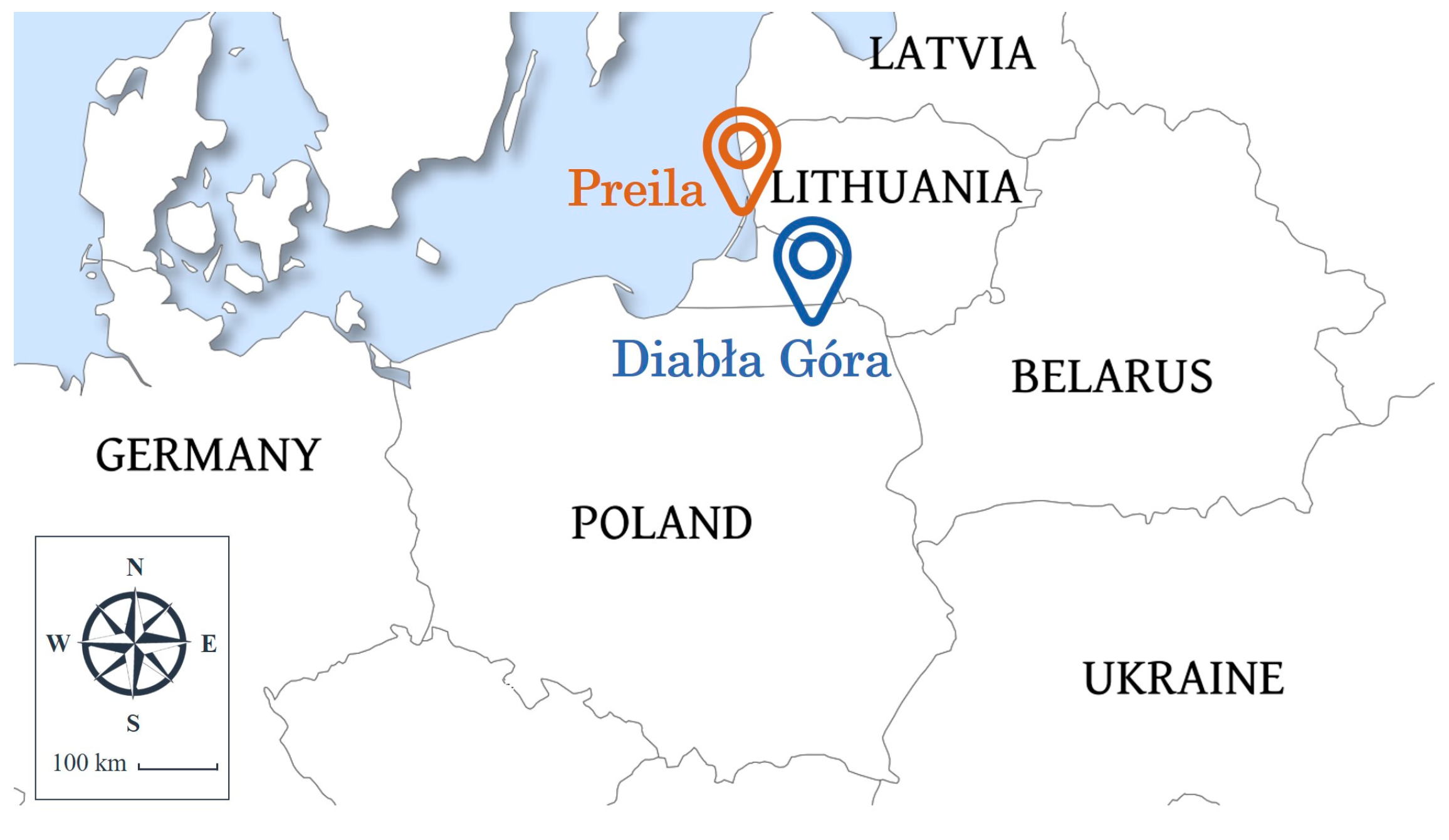
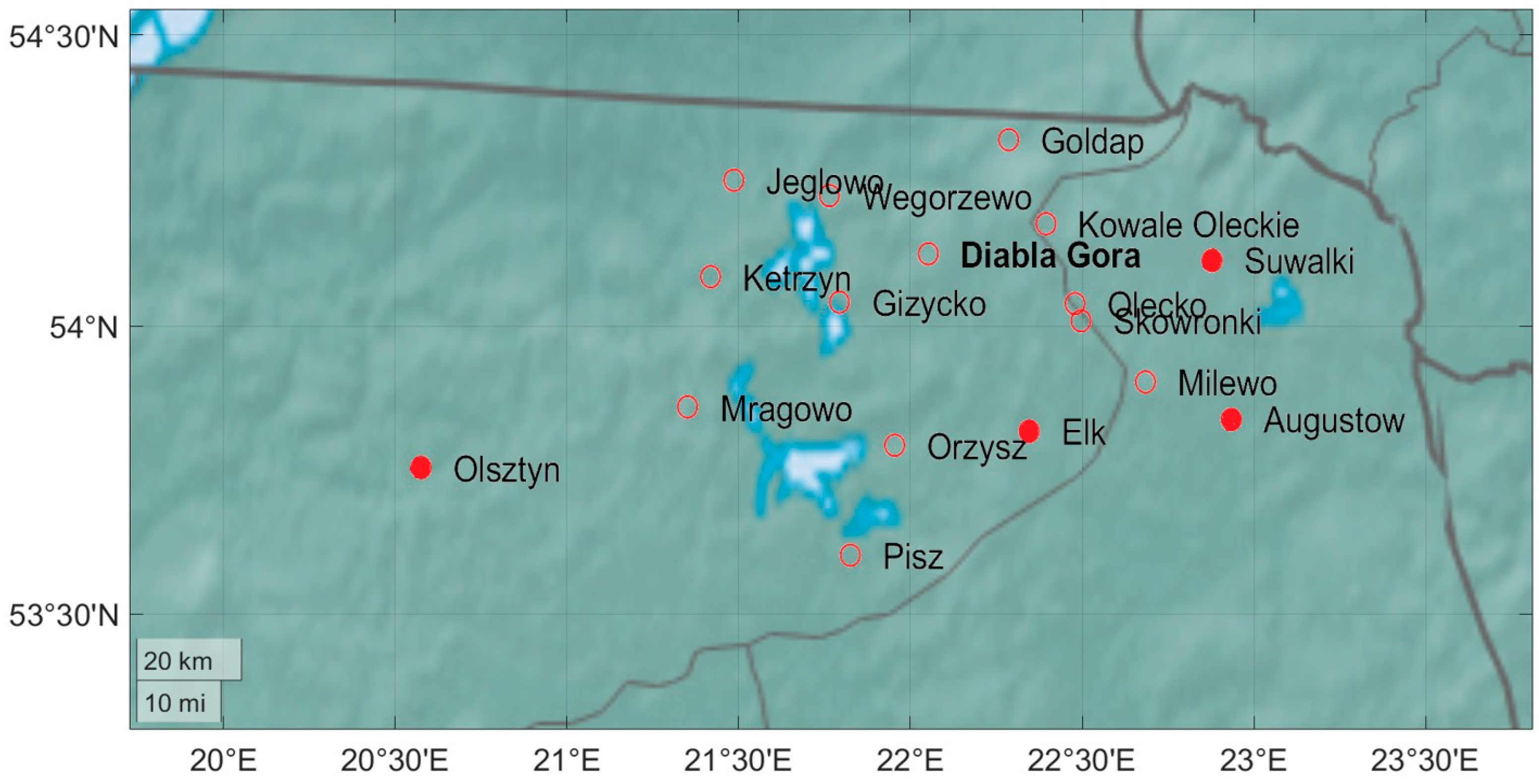
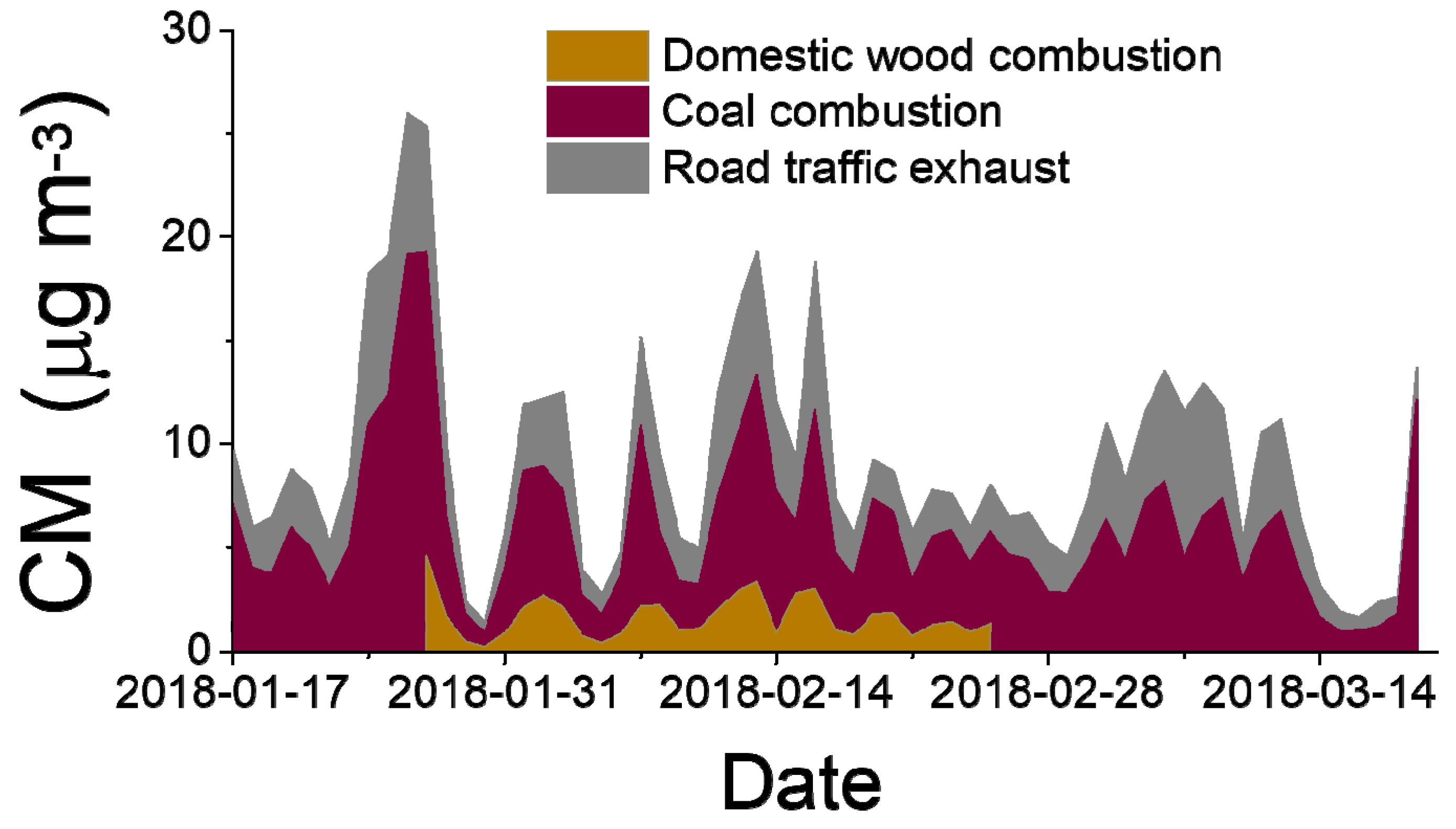

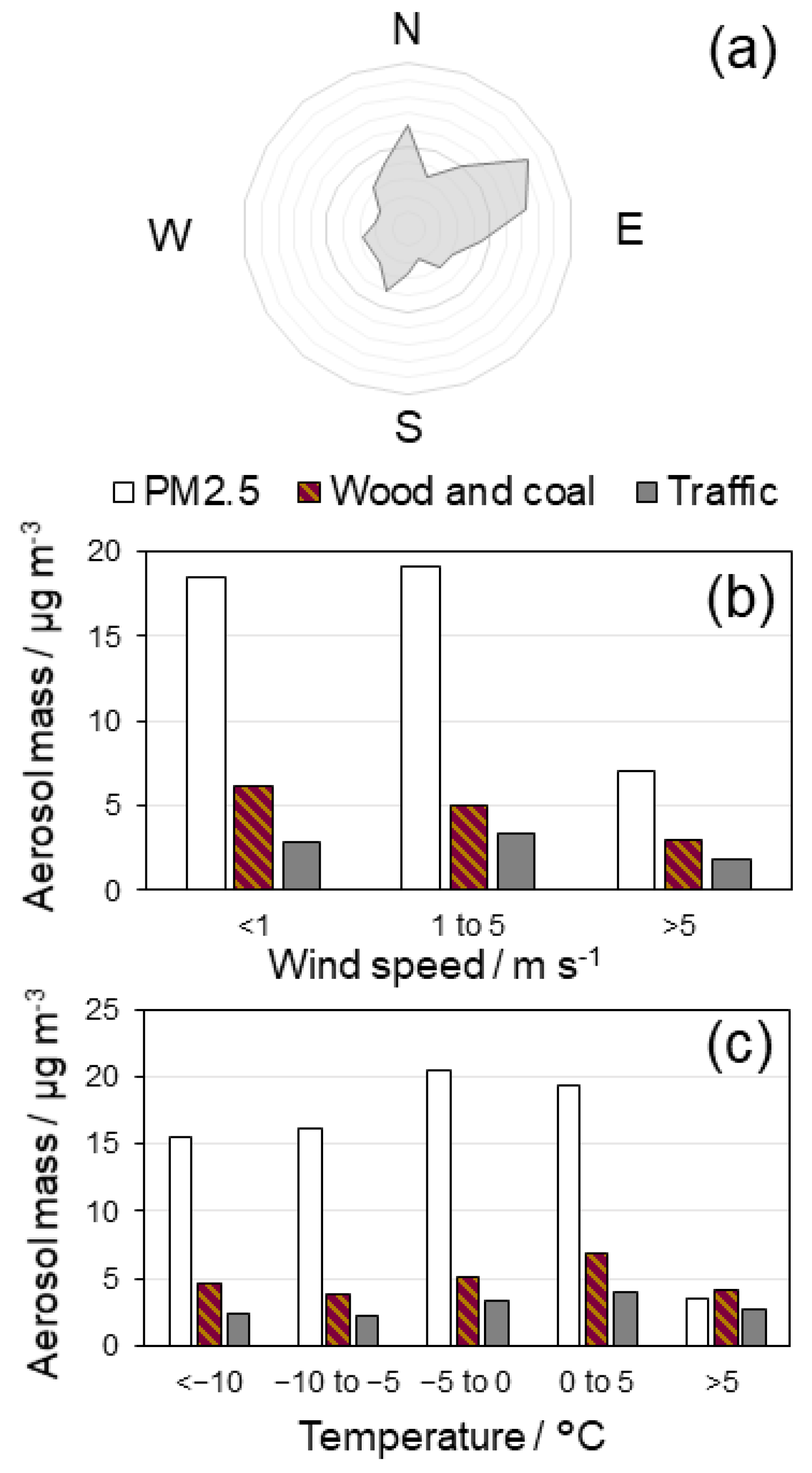

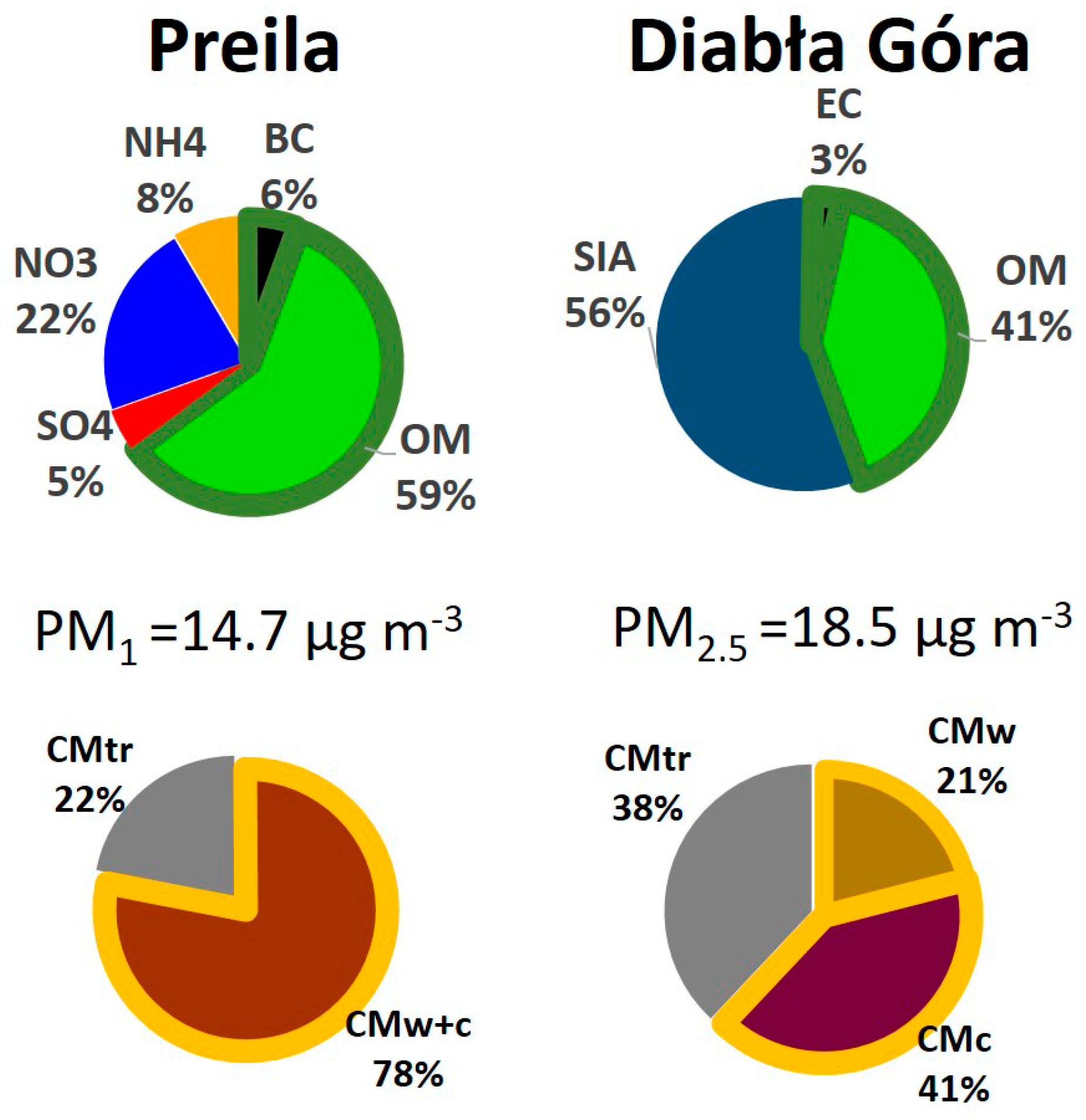
| Param. µg m−3 | Average ± 1std | Median | 10th Percentile | 90th Percentile | Period during 2018 | Time Resolution |
|---|---|---|---|---|---|---|
| PM2.5 | 18.5 ± 9.3 | 16.1 | 6.8 | 32 | 1/17–3/19 | 24 h |
| PM1 | 10.0 ± 6.4 | 7.8 | 4.2 | 15.6 | 1/27–2/6 | 24 h |
| CM | 8.2 ± 4.4 | 7.5 | 2.9 | 14.2 | 1/17–3/19 | 24 h |
| OM | 7.6 ± 4.1 | 7.0 | 2.7 | 13.3 | 1/17–3/19 | 24 h |
| OC | 4.5 ± 2.5 | 4.1 | 1.57 | 7.8 | 1/17–3/19 | 24 h |
| EC | 0.57 ± 0.28 | 0.52 | 0.26 | 0.94 | 1/17–3/19 | 24 h |
| levogl. | 0.134 ± 0.084 | 0.113 | 0.058 | 0.24 | 1/27–2/25 | 24 h |
| eBC | 1.04 ± 0.62 | 0.86 | 0.33 | 1.76 | 1/17–3/19 | 1 min |
| CM/PM2.5 | 0.44 ± 0.08 | 0.45 | 0.35 | 0.52 | 1/17–3/19 | 24 h |
| CM/PM1 | 0.61 ± 0.08 | 0.64 | 0.51 | 0.67 | 1/27–2/6 | 24 h |
| Source | Average Contribution (and Median) (µg m−3) | Relative Average (and Median) Contribution | Sensitivity Range of Average Contribution |
|---|---|---|---|
| Domestic wood combustion | 1.63 (1.38) | 21 (21)% | 16–32% |
| Domestic coal combustion | 3.2 (2.9) | 41 (44)% | 30–46% |
| Road traffic exhaust | 2.9 (2.3) | 38 (35)% | 23–51% |
| Parameter | Average ± 1std | Min | Max |
|---|---|---|---|
| Temperature (°C) | −3.6 ± 5.8 | −22.2 | 10.0 |
| Wind Speed (m s−1) | 2.1 ± 1.6 | 0 | 8.3 |
| Precipitation 12 h (mm) a | 0.43 ± 1.16 | 0 | 11.4 |
| Precipitation 24 h (mm) b | 0.90 ± 2.08 | 0 | 17.9 |
© 2020 by the authors. Licensee MDPI, Basel, Switzerland. This article is an open access article distributed under the terms and conditions of the Creative Commons Attribution (CC BY) license (http://creativecommons.org/licenses/by/4.0/).
Share and Cite
Kristensson, A.; Ausmeel, S.; Pauraite, J.; Eriksson, A.; Ahlberg, E.; Byčenkienė, S.; Degórska, A. Source Contributions to Rural Carbonaceous Winter Aerosol in North-Eastern Poland. Atmosphere 2020, 11, 263. https://doi.org/10.3390/atmos11030263
Kristensson A, Ausmeel S, Pauraite J, Eriksson A, Ahlberg E, Byčenkienė S, Degórska A. Source Contributions to Rural Carbonaceous Winter Aerosol in North-Eastern Poland. Atmosphere. 2020; 11(3):263. https://doi.org/10.3390/atmos11030263
Chicago/Turabian StyleKristensson, Adam, Stina Ausmeel, Julija Pauraite, Axel Eriksson, Erik Ahlberg, Steigvilė Byčenkienė, and Anna Degórska. 2020. "Source Contributions to Rural Carbonaceous Winter Aerosol in North-Eastern Poland" Atmosphere 11, no. 3: 263. https://doi.org/10.3390/atmos11030263
APA StyleKristensson, A., Ausmeel, S., Pauraite, J., Eriksson, A., Ahlberg, E., Byčenkienė, S., & Degórska, A. (2020). Source Contributions to Rural Carbonaceous Winter Aerosol in North-Eastern Poland. Atmosphere, 11(3), 263. https://doi.org/10.3390/atmos11030263







